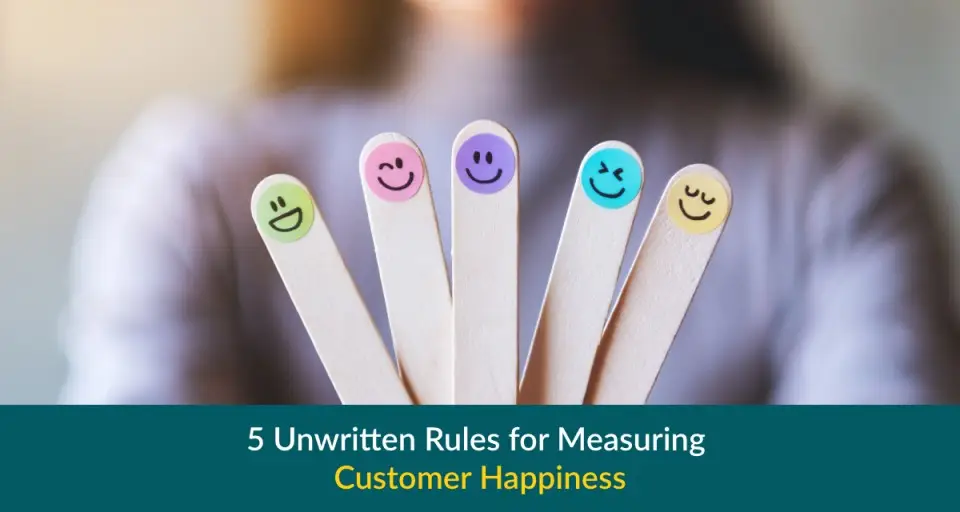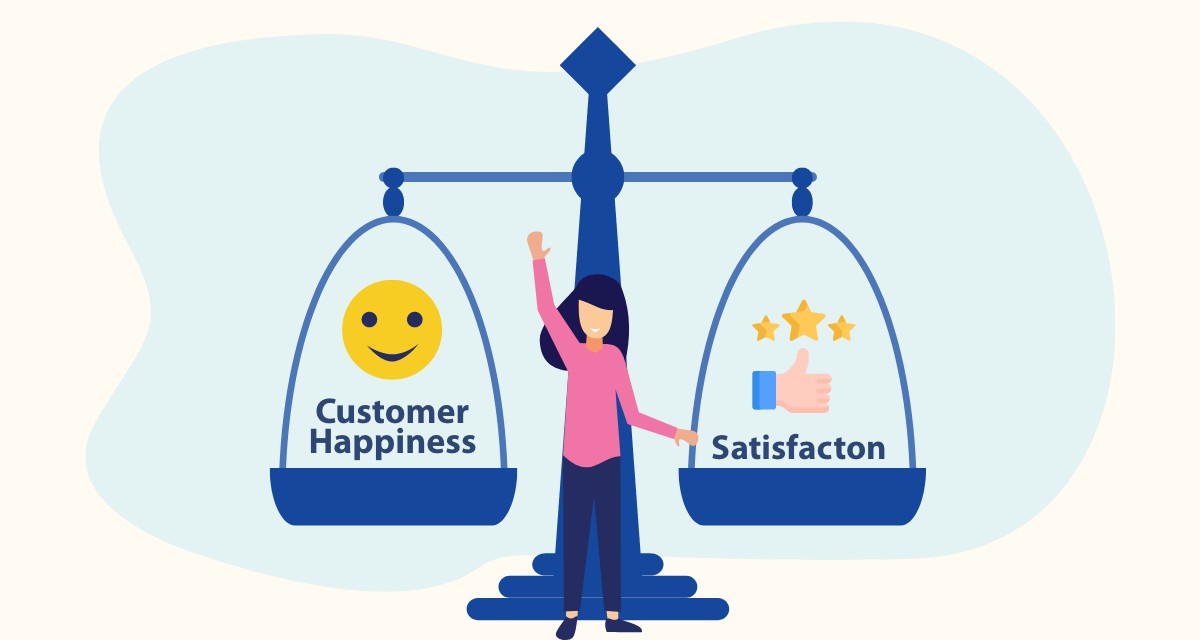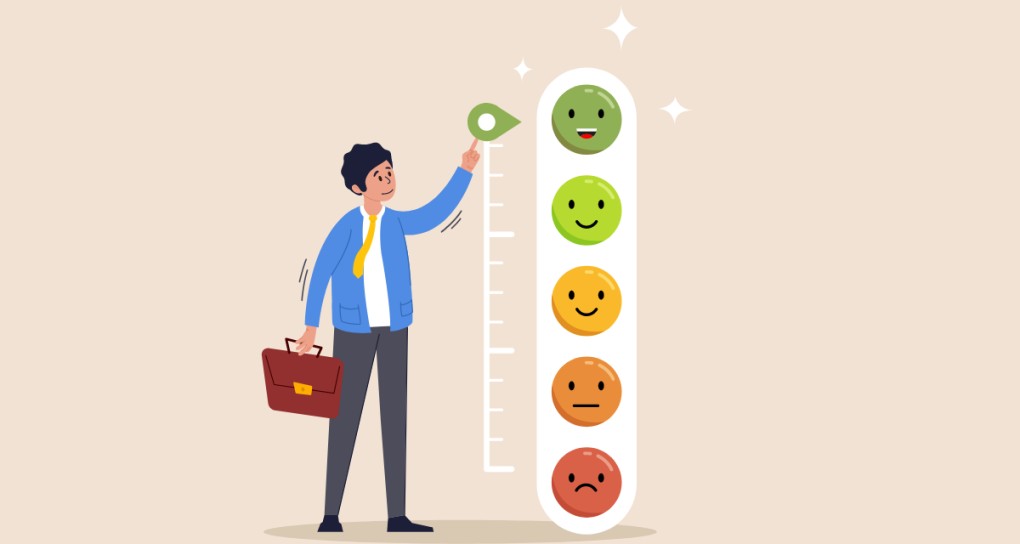If you look at how modern businesses operate versus how things used to be done in the past, the difference is night and day. And sure, technology has a lot to do with it. But even though technology has evolved, certain fundamentals of customer satisfaction remain unchanged.
Customer happiness results from your clients’ satisfaction and joy when working with you. Customer happiness depends on how successfully customer demands are addressed at every step of the customer experience. Customers’ level of engagement with a brand and their sense of long-term loyalty comes directly from their satisfaction and happiness with a brand.
There is no set formula that a business can just follow and succeed. However, there are certain things that you should do to improve your relationship with your customers that would help you grow your business.
Understanding what makes your customers happy will help you cultivate lasting trust and loyalty. But before discussing how to measure customer satisfaction, let’s first understand customer happiness.
How Does Customer Happiness Differ From Customer Satisfaction?
Although the terms customer satisfaction and customer happiness are frequently used synonymously, they don’t mean the same thing. Customer satisfaction often measures how a customer feels about a company, product, or service at a particular period.
Measures like CSAT can assess customers’ satisfaction with a specific purchase or business engagement (for example, when interacting with your support staff).
On the other hand, customer happiness is a broader concept of which customer satisfaction is a small part. When a customer is pleased with a brand, you can assume they have experienced an emotional connection with it, not once or twice, but repeatedly. As a result, they are eager to return to the brand, and over time, there is growth in customer lifetime value.
But one thing unites these concepts: brand loyalty contributes to customer satisfaction and happiness.
The Connection Between Customer Happiness and Customer Loyalty
Customer happiness and loyalty are intertwined. Monitoring happiness helps businesses understand customer behavior and refine customer loyalty programs accordingly.
- Positive Interactions: Happy customers are more forgiving of brand mistakes due to their emotional attachment.
- Brand Advocacy: Satisfied customers enthusiastically recommend the brand to others, strengthening its reputation.
- Perceived Value: Customer contentment reflects the value they perceive in the brand, boosted by effective loyalty programs.
- Customer Retention: Ensuring customer happiness prevents shifts to competitors, sustaining a stable customer base.
- Enhanced Lifetime Value: Happy customers remain loyal, increasing customer long-term value and maximizing returns from loyalty initiatives.

A recent statistic reveals a compelling insight: as many as 81% of customers state that a positive experience with a company significantly increases their likelihood of making another purchase. This statistic, highlighted in a 2023 report by Zendesk, underscores the critical importance of customer happiness and satisfaction in fostering repeat business and loyalty. This trend emphasizes how vital it is for businesses to prioritize and continuously improve their customer experience strategies.
What is Customer Loyalty and How it Affects Your Business?
Customer loyalty is a customer’s inclination to do business with a company frequently. This is usually a result of their beautiful and outstanding interactions with that brand.
Customer Loyalty Impacts
Following are some of the significant impacts that customer loyalty can have on your business:-
1. A higher share of the wallet
The term “share-of-wallet” describes how much a customer spends on a particular brand compared to how much they spend on the brand’s rivals. Customers who are loyal to a brand convert and spend more time and money. That will increase your portion of the wallet.
2. Better Referrals via Word of Mouth
Loyal customers are likely to share positive reviews and refer the brand to others. These customers recommend those products to their friends and coworkers, which promotes word-of-mouth advertising and referral traffic.
3. Enhanced Trust
Loyal customers trust your brand because they believe that the benefits of the relationship outweigh any potential advantages they might receive from one of your competitors.
Now that you have understood customer loyalty and how it impacts your business, let’s unpack the five unwritten rules for measuring customer happiness.
Rules for Measuring Customer Happiness:
- Measure for Anticipatory Service
- Use the Correct Metrics
- Sources of Your Data
- Smooth Feedback Process
- Don’t Ignore Negative Feedbacks
How to Measure Customer Happiness: 5 Unwritten Rules
Rule 1: Measure So That You Can Deliver Anticipatory Service
The point of assessing customer satisfaction successfully is to ascertain their pain points. And not just those pain points they point out to you, but those customers aren’t aware of themselves, or at least don’t expect YOU to address them.
You measure customer satisfaction to anticipate pain points during a buyer’s journey to remove them. But how does it impact a customer’s experience and overall satisfaction with a brand? Let’s understand this with an example.
A brand operates a retail loyalty program that offers members exclusive discounts, personalized recommendations, and early access to sales. Utilizing surveys, reviews, and customer service interactions, the brand found its redemption process too complex.
The brand took proactive steps to simplify the redemption process, making it more straightforward and user-friendly. This significantly enhanced customer experience and positively impacted their overall satisfaction with the loyalty program and, by extension, their brand perception.
You are on the right path if you are measuring customer happiness to deliver stellar anticipatory service to your target audience.
Rule 2: Look At Different Customer Happiness Metrics to Better Map Customer Experience
According to an article published in Harvard Business Review, businesses at the pinnacle of their respective industries regarding Net Promoter Scores or satisfaction rankings for three or more years show a 2.5 times faster revenue growth than their competitors. Not only that, over 10 years, these businesses return two to five times the shareholder value that their peers deliver.
It’s safe to say that certain customer happiness metrics are quite helpful in mapping customer experience. However, instead of relying on a single metric, it is better to consider various factors. It gives a more comprehensive view of customer happiness. Following are a few key metrics that a business should be taking into account-
a. The Customer Happiness Score (CSAT)
This is an important indicator that evaluates user happiness through surveys done after significant encounters.
b. Net Promoter Score (NPS)
This assesses the chance of customers recommending a product or service to determine total customer loyalty. Respondents are classified as Detractors (least likely to suggest), Passives (neutral), or Promoters (superfans) by NPS.
c. Customer Effort Score (CES)
This assesses the ease of customer interactions, with high effort indicating probable discontent.
d. DAU (Daily Active Users) to MAU(Monthly Active Users) Ratio
Calculate product or loyalty program stickiness by dividing your daily active users by your monthly active users.
DAUMAU= Stickiness Metric
Rule 3: When and From Whom You Collect Data Matters as Much as How You Collect It
Timing is critical for effectively measuring customer contentment. Surveys undertaken too quickly may appear forceful, while those conducted too late may provide incorrect results owing to fading memory. Surveys should ideally be sent out following important customer lifecycle milestones, maintaining closeness to the experience for reliable input.
Businesses should make sure that surveys strategically align with significant customer lifecycle milestones, ensuring close proximity to the customer experience for reliable feedback. Key survey points include post-redemption surveys, anniversary or milestone surveys, transaction-based surveys, periodic satisfaction check-ins, and feedback on new features or updates. Additionally, integrating feedback mechanisms within a loyalty program’s interface and occasionally organizing in-person or virtual focus groups further enrich the understanding of customer happiness.
Tailoring surveys to specific customer segments, such as recent buyers or long-term customers, ensures valuable and relevant data. The goal is to collect actionable insights and drive continuous improvement in the loyalty program to enhance overall customer satisfaction.
Rule 4: Make the Process of Submitting Feedback as Smooth as Possible for the Customer
The survey procedure must be simplified and made convenient to improve customer input. One helpful strategy is to streamline the survey procedure, making it as simple as possible for customers. This can be accomplished by embedding the feedback survey within the loyalty program or the marketing emails. You eliminate the requirement for clients to visit a separate platform or webpage by allowing them to rate the service or experience within the same email where they obtain a solution.
For instance, customers could be prompted to rate their recent reward redemption experience within a loyalty program app or provide feedback on various rewards available. Therefore by eliminating the need for customers to visit a separate platform or webpage, this integration saves them time and effort, ultimately increasing the likelihood of their active participation. This seamless integration saves them time and enhances the possibility that they would participate. This also increases their ability to submit feedback immediately after their issue has been fixed increasing the likelihood of capturing their thoughts, and offering useful insights for the organization.
Rule 5: Never Make the Mistake of Ignoring Negative Feedback
According to a 2020 report on customer experience trends, around 50% of customers responded that they would go for an alternative brand after just one bad experience with their current brand. Not only that, this percentage grows to a whopping 80% if more than one bad experience is involved.
Hence, businesses must prioritize client satisfaction. When undesirable feedback is addressed, it helps to improve the customer experience. In April 2017, a United Airlines customer was forcibly removed owing to an overbooked aircraft, resulting in a viral outrage. United Airlines’ insufficient response resulted in a public relations disaster, a drop in stock price, legal battles, and policy reforms. This episode emphasizes the importance of empathic customer service, particularly in the social media age, where unpleasant incidents may swiftly affect public opinion, underlining businesses’ need to be proactive and polite in resolving customer complaints.
Conclusion
Customer happiness is what you should be aiming for as a business owner. No matter how small a decision or action, it should be focused on enhancing the customer experience.
A brand should have a strong grasp of how happy or unhappy customers are with its services, products, or interactions. Only then can you make the changes necessary to forge a more favorable opinion about your brand among your target audience.
Key Takeaways & Actionable Steps
Understanding Customer Happiness: Goes beyond satisfaction, it reflects emotional connection and long-term loyalty.
Impact of Customer Loyalty: Loyal customers spend more, recommend the brand, and enhance trust and reputation.
Rule #1 Anticipatory Service: Measure happiness to proactively address customer pain points during their journey.
Rule #2 Utilize Multiple Metrics: Consider various metrics like CSAT, NPS, CES, and user engagement for a comprehensive view.
Rule #3 Timing and Data Collection: Collect feedback at the right milestones, integrating surveys within loyalty programs for valuable insights.
Rule #4 Simplify Feedback Submission: Integrate surveys into emails and loyalty program interfaces for easy and prompt feedback.
Rule #5 Address Negative Feedback: Promptly address negative feedback to prevent customer churn and maintain brand reputation.
Ready to Build Your Loyalty Program With Zinrelo?
Learn how our holistic loyalty platform can transform your business.




